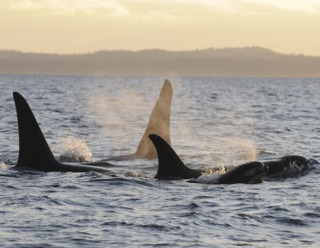Researchers have confirmed the birth of another J pod orca, bumping the precarious Southern resident killer whale population to 86.
“Thanks to a call from Jeanne Hyde, Dave Ellifrit, John Durban and I got out with J pod in Haro Strait just before sunset last night,” Ken Balcomb of the Center for Whale Research reported on the Orca Network Web site March 3. “(We) confirmed that there are now TWO new babies in J pod: J44 with J17 and J45 with J14. Both babies appeared to be in good condition and energetic.”
Confirmation of the birth came two weeks after the confirmation that two calves had been born to J and L pods; those calves were designated J44 and L112. The latest calf was designated J45.
“They look fat and healthy. We’re encouraged,” Durban said today.
Researchers are cautious on the whale population number because one adult male orca, L57, has not been seen with his pod since November.
But those three new calves could continue to have a fat and healthy first year, thanks to cooler water temperatures. La Nina conditions mean better feeding conditions for salmon and, thus, better salmon runs.
Jack Giard, a member of the Pacific Salmon Commission’s Fraser River panel, said today that 17.6 million pinks and 10.6 million sockeye are expected to return to the Fraser this year. “We have a large forecast of chinook coming. The Columbia River stocks look good too,” he said.
Balcomb said it’s unusual for the three whale pods to be in inland waters in winter. Balcomb believes their presence here is linked to the depressed runs of Central Valley stock chinook in California, the whales’ usual winter hunting area.
“Our typical first sighting is about May,” Balcomb said.
The center’s records have the current Southern resident orca population at 25 in J pod, 19 in K, and 42 in L — if L57 shows up.
The historical average age for male Southern resident killer whales is 29, with a maximum in the 50s, Balcomb said. The historical average for females is 52; the oldest female, J-2, is in her 90s and may be 100.
The whales’ population has seesawed over the past several years. Six orcas disappeared in 2008, dropping the population to 83, the lowest since 2003.
The Center for Whale Research and others blame marine pollution, depleted salmon runs, and acoustic impacts from dredging, seismic testing and military sonar for the decline in the population.
One of the whales believed to have died last year, L67, showed signs of malnourishment the last time she was seen; she had “peanut head,” a term for a depressed area behind the blowhole that normally stores fat. L67’s offspring also have not fared well: L98, also known as Luna, separated from the pod in Nootka Sound in 2002 and was killed by a boat propeller in 2006. L101, a juvenile male, failed to return with the pod last year.
The resident orcas have long been beleaguered. In the late 1800s and early 1900s, fishermen saw them as competition and shot them. Later, orcas were captured for marine parks.
Their population, believed to have once been in the 120s, plummeted to 71 by 1973. It rebounded to 99 in 1995, then plummeted to 79 six years later.
The population rebounded to 80 in 2002, 83 in 2003, 85 in 2004 and 89 in 2005, then seesawed around 88 since then. The local pods were declared endangered by the U.S. and Canada by 2005 and the National Oceanographic and Atmospheric Administration has been patrolling the area to enforce rules requiring boats to maintain a distance of 100 yards from the whales.
In an earlier interview, Balcomb said the ups and downs of the orca population over the last 30 years parallel the ups and downs of the chinook salmon population. “If the chinook population doesn’t do well, the whale population doesn’t do well,” he said.
Balcomb suggested that a 10-year moratorium on salmon fishing would enable salmon populations to rebound. But even a suggestion of a moratorium by fisheries managers would be politically difficult, he said.




